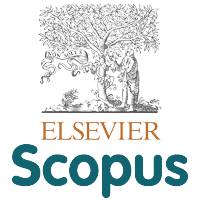Comparison of Two Trap Designs for Monitoring the Bark and Ambrosia Beetles (Curculionidae: Scolytinae and Platypodinae) in Mahogany Forests
Abstract
Bark and ambrosia beetles are commonly found in forest ecosystems, and their fungal symbionts act as plant pathogens. Accurate information on the presence and population levels of bark and ambrosia beetles is becoming an increasingly crucial to protect the forest ecosystem. This study compared multiple-funnel and bottle traps to monitor the bark and ambrosia beetles in two types of mahogany forest. Multiple-funnel and bottle traps were made from transparent polyethylene terephthalate bottles and baited with 95% ethanol. Two different mahogany forest management (monoculture and polyculture with coffee plants) were used in this study. A total of 2,367 bark and ambrosia beetle specimens were trapped in this study. This research recorded ten genera of Scolytinae and one Platypodinae genus. Xyleborus spp., X. crassiusculus, and P. cavipennis are three predominated ambrosia beetles collected in mahogany monoculture and polyculture. Euplatypus parallelus was identified as a representative of Platypodinae. Results showed that multiple-funnel traps baited with ethanol are effective to catch individuals and several species of bark and ambrosia beetles in mahogany forests. The choice of multiple-funnel or bottle traps is an important consideration in trap-based programs for monitoring or detecting invasive species in forest ecosystems.
Keywords
Full Text:
PDFReferences
Agnello, A., Breth, D., Tee, E., Cox, K., & Warren, H. R. (2015). Ambrosia Beetle – An Emergent Apple Pest. New York Fruit Quarterly, 23(1), 25–28. PDF
Bateman, C., Huang, Y.-T., Simmons, D. R., Kasson, M. T., Stanley, E. L., & Hulcr, J. (2017). Ambrosia beetle Premnobius cavipennis (Scolytinae: Ipini) carries highly divergent ascomycotan ambrosia fungus, Afroraffaelea ambrosiae gen. nov. et sp. nov. (Ophiostomatales). Fungal Ecology, 25, 41–49. DOI
Beaver, R. (2013). The invasive neotropical ambrosia betle Euplatypus parallelus (Fabricus, 1801) in the oriental region and its pest status (Coleoptera: Curculionidae, platypodinae). Entomologist’s Monthly Magazine, 149, 143–154.
Boland, J. M. (2016). The impact of an invasive ambrosia beetle on the riparian habitats of the Tijuana River Valley, California. PeerJ, 4, e2141. DOI
Burbano, E. G., Wright, M. G., Gillette, N. E., Mori, S., Dudley, N., Jones, T., & Kaufmann, M. (2012). Efficacy of Traps, Lures, and Repellents for Xylosandrus compactus (Coleoptera: Curculionidae) and Other Ambrosia Beetles on Coffea arabica Plantations and Acacia koa Nurseries in Hawaii. Environmental Entomology, 41(1), 133–140. DOI
Cavaletto, G., Faccoli, M., Ranger, C. M., & Rassati, D. (2021). Ambrosia beetle response to ethanol concentration and host tree species. Journal of Applied Entomology, 145(8), 800–809. DOI
Covre, L. de S., Melo, A. A., & Flechtmann, C. A. H. (2021). Flight activity and spread of Xylosandrus crassiusculus (Motschulsky) (Coleoptera: Curculionidae) in Brazil. Trees, Forests and People, 4, 100076. DOI
Egonyu, J. P., Ahumuza, G., & Ogari, I. (2016). Population dynamics of Xylosandrus compactus (Coleoptera: Curculionidae: Scolytinae) on Coffea canephora in the Lake Victoria Crescent agroecological zone of Uganda. African Zoology, 51(3), 121–126. DOI
Flechtmann, C. A. H., Ottati, A. L. T., & Berisford, C. W. (2000). Comparison of Four Trap Types for Ambrosia Beetles (Coleoptera, Scolytidae) in Brazilian Eucalyptus Stands. Journal of Economic Entomology, 93(6), 1701–1707. DOI
Galko, J., Dzurenko, M., Ranger, C., Kulfan, J., Kula, E., Nikolov, C., Zúbrik, M., & Zach, P. (2018). Distribution, Habitat Preference, and Management of the Invasive Ambrosia Beetle Xylosandrus germanus (Coleoptera: Curculionidae, Scolytinae) in European Forests with an Emphasis on the West Carpathians. Forests, 10(1), 10. DOI
Grousset, F., Grégoire, J.-C., Jactel, H., Battisti, A., Benko Beloglavec, A., Hrašovec, B., Hulcr, J., Inward, D., Orlinski, A., & Petter, F. (2020). The Risk of Bark and Ambrosia Beetles Associated with Imported Non-Coniferous Wood and Potential Horizontal Phytosanitary Measures. Forests, 11(3), 342. DOI
Gugliuzzo, A., Biedermann, P. H. W., Carrillo, D., Castrillo, L. A., Egonyu, J. P., Gallego, D., Haddi, K., Hulcr, J., Jactel, H., Kajimura, H., Kamata, N., Meurisse, N., Li, Y., Oliver, J. B., Ranger, C. M., Rassati, D., Stelinski, L. L., Sutherland, R., Tropea Garzia, G., … Biondi, A. (2021). Recent advances toward the sustainable management of invasive Xylosandrus ambrosia beetles. Journal of Pest Science, 94(3), 615–637. DOI
Gümüş, E. M., & Ergün, A. (2015). Report of a pest risk analysis for Platypus parallelus (Fabricus, 1801) for Turkey. EPPO Bulletin, 45(1), 112–118. DOI
Hughes, M. A., Riggins, J. J., Koch, F. H., Cognato, A. I., Anderson, C., Formby, J. P., Dreaden, T. J., Ploetz, R. C., & Smith, J. A. (2017). No rest for the laurels: Symbiotic invaders cause unprecedented damage to southern USA forests. Biological Invasions, 19(7), 2143–2157. DOI
Hughes, M. A., Smith, J. A., Ploetz, R. C., Kendra, P. E., Mayfield, A. E., Hanula, J. L., Hulcr, J., Stelinski, L. L., Cameron, S., Riggins, J. J., Carrillo, D., Rabaglia, R., Eickwort, J., & Pernas, T. (2015). Recovery Plan for Laurel Wilt on Redbay and Other Forest Species Caused by Raffaelea lauricola and Disseminated by Xyleborus glabratus. Plant Health Progress, 16(4), 173–210. DOI
Hulcr, J., Gomez, D. F., & Johnson, A. J. (2022). Collecting and preserving bark and ambrosia beetles (Coleoptera: Curculionidae: Scolytinae & Platypodinae). PLOS ONE, 17(4), e0265910. DOI
Kelsey, R. G., Beh, M. M., Shaw, D. C., & Manter, D. K. (2013). Ethanol attracts scolytid beetles to Phytophthora ramorum cankers on coast live oak. Journal of Chemical Ecology, 39(4), 494–506. DOI
Kendra, P. E., Montgomery, W. S., Narvaez, T. I., & Carrillo, D. (2020). Comparison of Trap Designs for Detection of Euwallacea nr. fornicatus and Other Scolytinae (Coleoptera: Curculionidae) That Vector Fungal Pathogens of Avocado Trees in Florida. Journal of Economic Entomology, 113(2), 980–987. DOI
Lantschner, M. V., Corley, J. C., & Liebhold, A. M. (2020). Drivers of global Scolytinae invasion patterns. Ecological Applications : A Publication of the Ecological Society of America, 30(5), e02103. DOI
Lin, W., Xu, M., Gao, L., Ruan, Y., Lai, S., Xu, Y., & Li, Y. (2021). New records of two invasive ambrosia beetles (Curculionidae: Scolytinae: Xyleborini) to mainland China. BioInvasions Records, 10(1), 74–80. DOI
Lira-Noriega, A., Soberón, J., & Equihua, J. (2018). Potential invasion of exotic ambrosia beetles Xyleborus glabratus and Euwallacea sp. in Mexico: A major threat for native and cultivated forest ecosystems. Scientific Reports, 8(1), 10179. DOI
Mazón, M., Díaz, F., & Gaviria, J. C. (2013). Effectiveness of different trap types for control of bark and ambrosia beetles (Scolytinae) in Criollo cacao farms of Mérida, Venezuela. International Journal of Pest Management, 59(3), 189–196. DOI
Miller, D. R., & Crowe, C. M. (2009). Length of Multiple-Funnel Traps Affects Catches of Some Bark and Wood Boring Beetles in a Slash Pine Stand in Northern Florida. Florida Entomologist, 92(3), 506-507. DOI
Miller, D. R., Crowe, C. M., Ginzel, M. D., Ranger, C. M., & Schultz, P. B. (2018). Comparison of Baited Bottle and Multiple-Funnel Traps for Ambrosia Beetles (Coleoptera: Curculionidae: Scolytinae) in Eastern United States. Journal of Entomological Science, 53(3), 347–360. DOI
Olatinwo, R. O., Fraedrich, S. W., & Mayfield, A. E. (2021). Laurel Wilt: Current and Potential Impacts and Possibilities for Prevention and Management. Forests, 12(2), 181. DOI
R Core Development Team. (2018). R: A Language and Environment for Statistical Computing. R: A Language and Environment for Statistical Computing, 2. Available online: website
Rainho, H. L., Silva, W. D., & Bento, J. M. S. (2021). Semiochemical-Based Attractant for the Ambrosia Pinhole Borer Euplatypus parallelus. Agronomy, 11(2), 266. DOI
Ranger, C. M., Reding, M. E., Schultz, P. B., Oliver, J. B., Frank, S. D., Addesso, K. M., Hong Chong, J., Sampson, B., Werle, C., Gill, S., & Krause, C. (2016). Biology, Ecology, and Management of Nonnative Ambrosia Beetles (Coleoptera: Curculionidae: Scolytinae) in Ornamental Plant Nurseries. Journal of Integrated Pest Management, 7(1), 9. DOI
Ranger, C. M., Schultz, P. B., Frank, S. D., Chong, J. H., & Reding, M. E. (2015). Non-native ambrosia beetles as opportunistic exploiters of living but weakened trees. PLoS ONE, 10(7), e0131496. DOI
Ranger, C. M., Tobin, P. C., & Reding, M. E. (2015). Ubiquitous volatile compound facilitates efficient host location by a non-native ambrosia beetle. Biological Invasions, 17(2), 675–686. DOI
Rassati, D., Lieutier, F., & Faccoli, M. (2016). Alien Wood-Boring Beetles in Mediterranean Regions. In T. D. Paine & F. Lieutier (Eds.), Insects and Diseases of Mediterranean Forest Systems (pp. 293–327). Springer International Publishing. DOI
Reding, M. E., Schultz, P. B., Ranger, C. M., & Oliver, J. B. (2011). Optimizing ethanol-baited traps for monitoring damaging ambrosia beetles (Coleoptera: Curculionidae, Scolytinae) in ornamental nurseries. Journal of Economic Entomology, 104(6), 2017–2024. DOI
Setiawan, Y., Rachmawati, R., & Tarno, H. (2018). Diversity of ambrosia beetles (Coleoptera: Scolytidae) on teak forest in Malang District, East Java, Indonesia. Biodiversitas Journal of Biological Diversity, 19(5), 1791–1797. DOI
Smith, S., Beaver, R., Cognato, A., Hulcr, J., & Redford, A. (2019). Southeast Asian Ambrosia Beetle ID. USDA APHIS Identification Technology Program (ITP) and Michigan State University. Fort Collins, CO. website. [22 July 2023]
Smith, S. M., & Hulcr, J. (2015). Scolytus and other Economically Important Bark and Ambrosia Beetles. In Bark Beetles (pp. 495–531). Elsevier. DOI
Steininger, M. S., Hulcr, J., Šigut, M., & Lucky, A. (2015). Simple and Efficient Trap for Bark and Ambrosia Beetles (Coleoptera: Curculionidae) to Facilitate Invasive Species Monitoring and Citizen Involvement. Journal of Economic Entomology, 108(3), 1115–1123. DOI
Tarno, H., Setiawan, Y., Kusuma, C. B., Fitriyah, M., Hudan, A. N., Yawandika, A. P., Nasution, H. A., Saragih, R., Bagasta, A. P. Y., Wang, Z., & Wang, J. (2021). Diversity and Species Composition of Bark and Ambrosia Beetles Captured Using Ethanol Baited Traps on Different Hosts in East Java, Indonesia. Zoological Studies, 60, 1–9. DOI
Tarno, H., Setiawan, Y., Putri, R. A. A., Nardo, A., Tsamarah, F. G., Asri, J., & Wang, J. (2022). Effect of Pine Forest Management on the Diversity of Ambrosia Beetles (Curculionidae: Platypodinae and Scolytinae) in East Java, Indonesia. Diversity, 14(6), 484. DOI
Tarno, H., Setiawan, Y., Rahardjo, B. T., & Wang, J. (2021). Evaluation of the ambrosia beetles traps on Pterocarpus indicus in indonesia. Biodiversitas Journal of Biological Diversity, 22(3), 1332–1339. DOI
Tarno, H., Setiawan, Y., Wang, J., Ito, S., Mario, M. B., Kurahman, T., Suraningwulan, M., Amaliah, A. A., Sari, N. I., & Achmad, M. A. (2022). Partitioning of Ambrosia Beetle Diversity on Teak Plantations in Java, Sumbawa, and Sulawesi Islands. Forests, 13(12), 2111. DOI
Tarno, H., Suprapto, H., & Himawan, T. (2014). First record of ambrosia beetle (Euplatypus paralellus Fabricius) infestation on sonokembang (Pterocarpus indicus Willd.) from Malang Indonesia. AGRIVITA Journal of Agricultural Science, 36(2), 189–200. DOI
Thube, S. H., Pandian, R. T. P., Josephrajkumar, A., Bhavishya, A., Nirmal Kumar, B. J., Firake, D. M., Shah, V., Madhu, T. N., & Ruzzier, E. (2022). Xylosandrus crassiusculus (Motschulsky) on Cocoa Pods (Theobroma cacao L.): Matter of Bugs and Fungi. Insects, 13(9), 809. DOI
Túler, A. C., Valbon, W. R., Rodrigues, H. S., Noia, L. R., Santos, L. M. L., Fogaça, I., Rondelli, V. M., & Verdin Filho, A. C. (2019). Black twig borer, Xylosandrus compactus (Eichhoff), as a potential threat to the coffee production. Revista de Ciencias Agrícolas, 36(E), 9–20. DOI
Ward, S. F., & Riggins, J. J. (2023). Drivers of invasion by laurel wilt of redbay and sassafras in the southeastern US. Landscape Ecology, 38(2), 567–581. DOI
DOI: http://doi.org/10.17503/agrivita.v45i3.4295
Copyright (c) 2023 The Author(s)

This work is licensed under a Creative Commons Attribution-NonCommercial 4.0 International License.








